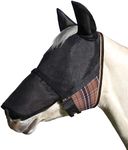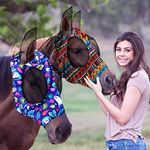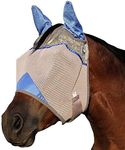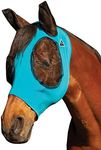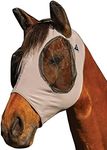Buying Guide for the Best Fly Mask Horse
Choosing the right fly mask for your horse is important for their comfort and protection. A fly mask shields your horse’s eyes, ears, and sometimes nose from annoying insects, dust, and UV rays. The right mask can help prevent irritation, infection, and stress caused by flies and other pests. When picking a fly mask, consider your horse’s daily environment, their sensitivity to bugs, and how much coverage they need. A good fit is essential to ensure the mask stays in place and doesn’t cause discomfort.Coverage AreaCoverage area refers to which parts of your horse’s face and head the mask protects. Some masks cover just the eyes, while others also shield the ears and nose. Eye-only masks are lighter and cooler, suitable for horses that don’t mind flies around their ears or nose. Masks with ear covers are great for horses sensitive to bugs in their ears, and those with nose covers help horses prone to sunburn or irritation on their muzzles. Think about your horse’s habits and sensitivities—if they often get bitten on the ears or have a pink nose, more coverage may be better.
Material and BreathabilityThe material of a fly mask affects how comfortable and durable it is. Most masks are made from mesh, which allows air to flow while keeping insects out. Some meshes are finer and softer, offering more comfort but possibly less durability, while thicker meshes last longer but may be stiffer. If your horse wears the mask for long periods or in hot weather, prioritize breathability and softness. For rougher horses or those in group turnout, a tougher material may be necessary to withstand wear and tear.
Fit and AdjustabilityFit and adjustability are crucial for your horse’s comfort and safety. A mask that’s too tight can cause rubbing and sores, while one that’s too loose may slip off or let insects in. Look for masks with adjustable straps, especially around the poll and under the jaw, to get a snug but comfortable fit. Horses with unique head shapes or those between sizes may benefit from more adjustable options. Always check for rubbing after the first few uses and adjust as needed.
VisibilityVisibility refers to how well your horse can see through the mask. The mesh should be fine enough to keep bugs out but not so dense that it blocks vision. Some masks have specially designed eye darts or structured areas to keep the mesh away from the eyes, preventing irritation and allowing clear sight. If your horse is active or easily startled, prioritize a mask that offers good visibility and doesn’t press on the eyes.
Closure TypeClosure type describes how the mask fastens onto your horse’s head. Common closures include Velcro, buckles, or hook-and-loop systems. Velcro is easy to use and adjust, but may wear out over time or be undone by playful horses. Buckles are more secure but can be harder to fasten. If your horse is in a group or tends to remove their mask, look for a secure closure. For ease of use, especially if you remove the mask daily, a simple and quick closure may be best.
